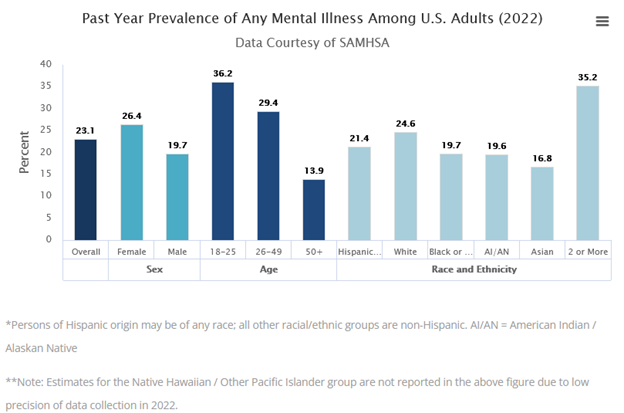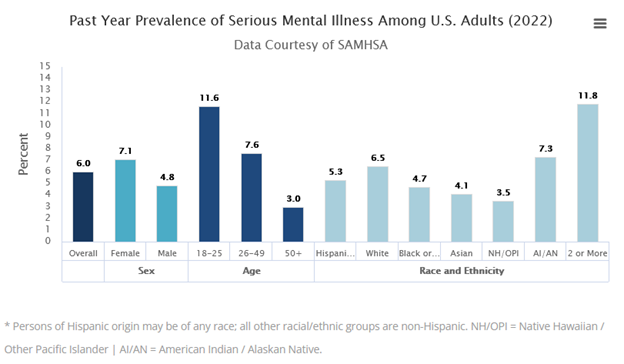Online Course
NRSG 780 - Health Promotion and Population Health
Module 10: Leading Causes of Morbidity and Mortality
Mental Health and Mental Disorders—Magnitude of the Problem and Prevention
Magnitude of the Problem
The burden of mental illness in the U.S. is among the highest of all diseases and mental disorders are among the most common causes of disability. The National Institute of Mental Health reported an estimated 59.3 million adults aged 18 and older, or approximately 23% of the population, with any mental illness (AMI) defined as a mental, behavioral or emotional disorder (excluding developmental and substance use disorders) diagnosed within the past year. An estimated 6%, or 15.4 million, of these adults are diagnosed with serious mental disability (SMI) resulting in significant functional impairment which substantially interferes with or limits one or more major life activities. Serious mental illness is associated with an estimated total economic cost of $317 billion per year. An additional 18.7 million or approximately 8% of the adult population have a substance use disorder and 10.2 million of these adults have both a mental disorder and a substance use disorder, defined as co-occurring disorders.
Sources:
https://www.nami.org/NAMI/media/NAMI-Media/Infographics/NAMI-You-Are-Not-Alone-FINAL.pdf
https://www.nimh.nih.gov/health/statistics/mental-illness#part_2539
Additional source: https://www.nami.org/NAMI/media/NAMI-Media/Infographics/GeneralMHFacts.pdf


Source:https://www.nimh.nih.gov/health/statistics/mental-illness
Mental disorders are common among children in the U.S. as well. Approximately 20% of children experience a seriously debilitating mental disorder. The following graphs show the lifetime prevalence of a mental health disorder for 13 to 18 year olds. It also shows that prevalence is equal for both genders, but does differ between various age groups for adolescents.

Mental health disorders are associated with the prevalence, progression and outcome of many of the leading causes of death. Mental illnesses, such as depression and anxiety, affect the ability to participate in health-promoting behaviors. Physical health problems can have a serious impact on mental health and influence the ability to participate in treatment and recovery. Individuals with untreated mental health disorders are at high risk for unhealthy and unsafe behaviors, including alcohol or drug abuse, violent or self-destructive behavior, and suicide. Adults with serious mental illness die on average 25 years earlier.
Treatment
Treatment for mental illness and substance use disorders is far from ideal. Approximately 60% of adults and 50% of children with mental illness received no mental health services in the previous year.
Source: http://www.nami.org/NAMI/media/NAMI-Media/Infographics/GeneralMHFacts.pdf
SAMHSA’s Behavioral Health Barometer provides an overview of the issues for the state of Maryland and the U. S. as a whole.

Prevention
Many mental health disorders can be treated effectively and prevention of mental health disorders is a growing area of research and practice. Early diagnosis and treatment can decrease the disease burden of mental health disorders as well as associated chronic diseases.
The existing model for understanding mental health and mental disorders emphasizes the interaction of social, environmental, and genetic factors throughout the lifespan. It focuses on risk factors which predispose individuals to mental illness and protective factors which reduce the risk of developing mental disorders at four levels: self, family, community and society.

Individual-level risk factors include genetic predisposition to addiction or exposure to alcohol prenatally, academic failure and scholastic demoralization, attention deficits, caring for chronically ill or dementia patients, child abuse and neglect, chronic insomnia, chronic pain, early pregnancies, elder abuse, emotional immaturity and dyscontrol, substance abuse, loneliness; poor work skills and habits, reading, sensory or functional disabilities, social incompetence and stressful life events
Individual-level protective factors can include positive self-image, self-control, social competence, ability to face adversity, autonomy, exercise, feelings of security, mastery and control, literacy, problem solving skills, self-esteem, conflict management skills, resiliency, socioemotional growth and stress management
Family-level risk factors include parents who use drugs and alcohol or who suffer from mental illness, child abuse and maltreatment and inadequate supervision, family conflict or disorganization
Family-level protective factors would be parental involvement, positive attachment and early bonding, social support of family and friends
Community-level risk factors include access to drugs and alcohol, displacement, isolation and alienation, lack of education, transport, housing; neighborhood disorganization, peer rejection, poverty, violence, poor nutrition, work stress and unemployment
Community-level protective factors might include the availability of faith-based resources and after-school activities, empowerment, positive interpersonal interactions, social support and community networks
Society-level risk factors can include norms and laws favorable to substance use, racial injustice and discrimination, social disadvantage, lack of economic opportunity and war
Society-level protective factors include policies limiting availability of substances or anti-hate laws, defending marginalized populations, social participation, social services, social responsibility and tolerance
In addition to advancements in the prevention of mental disorders, there continues to be steady progress in treating mental disorders as new drugs and stronger evidence-based outcomes become available.
This website is maintained by the University of Maryland School of Nursing (UMSON) Office of Learning Technologies. The UMSON logo and all other contents of this website are the sole property of UMSON and may not be used for any purpose without prior written consent. Links to other websites do not constitute or imply an endorsement of those sites, their content, or their products and services. Please send comments, corrections, and link improvements to nrsonline@umaryland.edu.